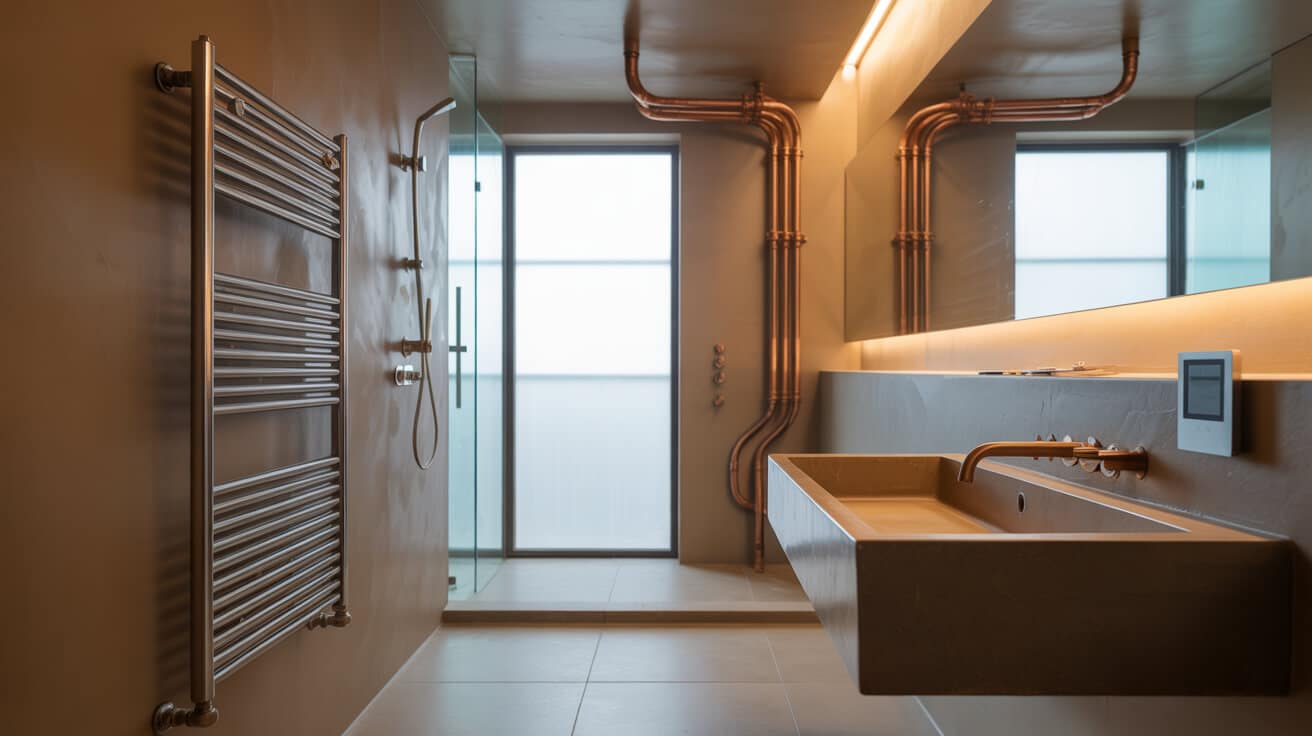MEES heating regulations require all affected properties to achieve a minimum energy performance, as measured by the Energy Performance Certificate (EPC) rating. Since April 2018, the minimum permitted rating for rental properties in England and Wales has been band E, and further tightening is proposed, with a possible move to band C across the next decade. These regulations are part of a wider policy framework designed to reduce carbon emissions from buildings, enhance quality of life for occupants, and ensure that the UK housing stock performs to a standard aligned with governmental net zero commitments. Landlords, letting agents, facility managers, and owners are responsible for ensuring compliance, with professional heating and plumbing contractors acting as technical partners in delivering upgrades and verifying regulatory conformance.
Etymology or name origin
The term “Minimum Energy Efficiency Standards” was first formalised in the UK legal context by the Energy Efficiency (Private Rented Property) Regulations 2015. The phrase draws from the broader global policy lexicon where “minimum standards” refer to basic legal thresholds, while “energy efficiency” encapsulates the goal of reducing unnecessary energy consumption in managed assets. MEES is now widely adopted in both technical and commercial documentation, acting as an anchor in legal contracts, compliance checklists, and sector guidance.
Overview and context
MEES targets the energy use associated with heating and hot water provision in the built environment, focusing on the private rented sector and select commercial sites. The regulations are explicitly embedded in the UK’s response to climate change and fuel poverty challenges, placing operational responsibility on property owners and agents to ensure that heating systems are efficient, effective, and compliant.
The rationale for these standards includes:
- Reducing national greenhouse gas emissions
- Protecting tenants from excess fuel costs and poor indoor climates
- Reducing healthcare burdens from cold homes and inefficient heating
- Shifting the asset management landscape toward lifecycle value and sustainability
Property types in scope range from single-family homes to large blocks and multi-let commercial premises. MEES bridges legal policy, practical engineering, and market incentives, requiring detailed attention to each building’s unique construction, plant, and occupancy patterns.
History
Origins
Efforts to regulate energy in UK buildings trace back to post-war construction codes, but substantive action began with the Building Regulations 1985 and their later amendments addressing insulation and heating efficiency. The Energy Performance of Buildings Directive, enacted via the Housing Act 2004 and subsequent regulations, introduced the EPC—a mechanism for measuring and disclosing building energy use upon sale or lease.
Industrial emergence
The 2011 Energy Act mandated creation of minimum efficiency standards for the private rented sector. Following consultation and pilot initiatives, MEES was enacted in 2015 for England and Wales, with Scotland and Northern Ireland adopting parallel but distinct programmes. The new regime made non-compliance an actionable breach, giving local authorities powers to levy fines and requiring public registration of exempted properties.
Contemporary evolution
From April 2018, it became unlawful to let out domestic properties with an EPC rating below E, unless specific exemptions applied. In April 2020, this threshold extended to all existing tenancies. Parallel non-domestic regulations apply to commercial properties, tailored to operational differences and greater plant diversity. Future policy iterations under review propose minimum rating C by 2025 for new tenancies and by 2028 for all lets, reflecting the government’s net zero roadmap.

Concept and description
MEES heating regulations are system-agnostic, focusing on building outcomes rather than prescribing particular technologies. Compliance relies on asset performance as measured by standard assessment metrics. The regulations integrate with the EPC scheme, which assigns a rating (A-G) based on annual modelled energy use for heating, hot water, and lighting.
Key components affecting compliance:
- Heating system efficiency: Boilers, heat pumps, or communal systems rated on their operational effectiveness, including SEDBUK values for boilers and coefficient of performance (COP) for heat pumps.
- Controls and zoning: Modern thermostats, time switches, TRVs (thermostatic radiator valves), and digital platforms enable more responsive system management, leading to lower wastage.
- Distribution and insulation: Insulation of pipework (thermal lagging), hot water cylinders, and walls/floors reduces heat loss and improves system economy.
- Renewable and low-carbon integration: Solar thermal panels, air/ground source heat pumps, and biomass boilers can provide direct EPC rating enhancements, especially when replacing legacy fossil-fuel assets.
Property audit pathways are flexible. For some, a simple boiler replacement suffices; for others, a layered approach combining multiple upgrades is required. Coordination with accredited technicians ensures that system improvements are aligned with both MEES and local building regulation requirements.
Functionality, purpose, and applications
MEES serve multiple simultaneous purposes, uniting legal, operational, and infrastructure considerations.
Intended outcomes
- Cut energy costs and reduce fuel poverty for tenants and businesses
- Reduce carbon dioxide emissions in line with national and international climate agreements
- Enhance asset value and competitiveness in the rental market
- Protect health by ensuring minimum standards for warmth and air quality
Applications in professional practice
- Landlords and property owners: must verify that heating systems are capable, reliable, and sufficient for the property size, using data from energy audits and illustrative upgrade scenarios.
- Letting and managing agents: are tasked with due diligence on the compliance status of managed portfolios, integrating EPC reviews and upgrade scheduling into tenancy cycles.
- Commercial facility managers: must account for complex plant, often involving distributed heat sources and multi-zoned control, making retrofit planning and performance benchmarking critical.
- Tenants: have rights enshrined in the regulations, including the ability to request improvement works or contest non-compliance.
- Plumbing and heating firms such as Plumbers 4U: offer a service continuum: from audit and diagnostic survey to system specification, installation, commissioning, and maintenance, along with comprehensive compliance reporting.
| Purpose | Property Owner/Agent Actions | Service Provider (Plumbers 4U) Actions |
|---|---|---|
| Reduce emissions | Schedule and record upgrades | Advise, design, instal compliant systems |
| Lower operating costs | Compare fuel/maintenance projections | Specify high-efficiency, low-maintenance options |
| Raise EPC rating | Commission audits, log results | Supply certified documentation post-upgrade |
| Meet legal obligations | Register for exemptions if needed | Ensure all works meet required standards |
Classifications and property coverage
MEES classify assets and compliance as follows:
Domestic rented properties
- Single-family homes and flats: —bound by EPC obligations if let under tenancy.
- Houses in multiple occupation (HMOs): —subject when individually let or when an EPC is required for the whole house.
- Built pre-regulation/heritage properties: —may claim exemption where upgrades are demonstrably unfeasible or detrimental.
Non-domestic and commercial
- Offices, retail, hospitality: —typically covered when a space is leased and an EPC is legally required.
- Communal/district heating: —compliance responsibilities are determined by asset ownership and management agreements.
- Mixed-use blocks: —require careful assessment of boundaries for EPC purposes.
Exemption criteria
- Cost cap: Required measures exceed seven-year payback or max cost threshold.
- Listed/building consent: Properties where planning/listed status precludes improvement.
- Third-party barriers: Declined permissions from superior landlord, tenant, or local authority.
- All measures applied: Documented effort to instal all permitted upgrades, yet EPC minimum not met.
Exemptions are non-perpetual; you or your organisation must re-register where circumstances change.
Systems, tools, and methodologies
Assessment systems
- EPC assessment tools: SAP software is the primary methodology, modelling heat loss, heating system performance, and consumption patterns.
- On-site measurement: Portable testers, thermographic imaging, and combustion analysis inform system condition evaluations for complex assets.
Implementation tools and workflows
- Survey templates and checklists: Efficient data capture underpins upgrade scoping and compliance evidence for your company.
- Digital controls integration: System upgrades commonly include smart, app-managed thermostats compatible with mobile platforms.
- Commissioning and maintenance records: Professional standards require signed-off documentation and handover packs.
Example upgrade workflow
- Initial audit and EPC assessment
- Option and benefit comparison
- Upgrade specification and quotation
- Installation and commissioning
- Post-upgrade EPC and compliance report
- Ongoing maintenance and monitoring (annual service, tenant feedback)
| Tool/Method | Used by | Output Produced |
|---|---|---|
| SAP/EPC software | Assessor, Plumbers 4U | EPC, compliance matrix |
| Infrared camera | Technician, FM | Heat loss profile |
| Datalogger | Installer, FM | Usage/occupancy patterns |
| Visual inspection | Landlord, Agent, FM | Physical asset register |

Stakeholders and entities involved
Primary actors
- Landlords and property managers: bear legal responsibility for compliance, engaging professionals for system upgrades and audits.
- Letting and managing agents: coordinate between property owners, tenants, and service providers.
- Plumbers 4U and similar contractors: deliver technical compliance, support asset management, and maintain regulatory records.
- EPC assessors and accreditation bodies: provide certification, validation, and periodic update of systems in situ.
- Facility managers and commercial operators: cover complex/multi-site and communal asset compliance.
Secondary/public actors
- Tenants and occupiers: exercise rights on minimum comfort and contestation of non-compliance.
- Local and national authorities: enforce MEES, process exemption registrations, and impose penalties.
- Industry bodies: (e.g., Chartered Institute of Plumbing and Heating Engineering, TrustMark) issue technical guidance and training.
Legal, regulatory, and ethical considerations
Statutory requirements
- Energy Efficiency (Private Rented Property) (England and Wales) Regulations 2015: —core legal framework
- Building Regulations, particularly Part L (conservation of fuel and power): —sets efficiency baselines for new works and major upgrades
- EPC obligation: —applies on letting, sale, and periodically for managed assets
Compliance process
- Document all EPC assessments, upgrades undertaken, and exemption registrations.
- Provide formal certificates to tenants/stakeholders and retain for audit (minimum six years).
- Non-compliance can result in escalating fines, rent repayment orders, and public disclosure.
Appeals and exemptions
- Formal protocols for appeals on exemption grounds are provided; you must submit evidence and wait for formal authority decision.
- Registered exemptions are time-limited and subject to periodic revalidation.
Ethical considerations
- Ensuring you balance compliance against tenant welfare and disruption minimization reinforces good practice in the sector.
- Transparency in outlining necessary works, timescales, and expenses to tenants, is encouraged for ongoing trust and market confidence.
Performance metrics, data, and measurements
Performance and compliance are measured via multiple metrics, including:
- EPC asset rating (A-G): Calculated via SAP, including measured or calculated system efficiency levels.
- Heating system benchmarks: Seasonal energy efficiency (e.g., SEDBUK), heat pump performance, smart control presence.
- Insulation values: Thermal resistance (R value), verified lagging, and documented measures for pipework and storage.
- Renewable share: The proportion of heating load met by renewables, as documented in EPC or supplemental calculation.
- Service reliability: Recorded downtime/outage, tenant thermal comfort data, and annual service logs.
Proper data capture supports both compliance and funding applications, with many authorities requiring uploaded evidence before grant disbursement.
| Metric | Typical Standard/Goal | Measurement Method |
|---|---|---|
| EPC Rating | E min (proposed C) | SAP/EPC assessment |
| Boiler Efficiency | >90% (condensing) | SEDBUK rating, engineer report |
| Pipe Insulation | Meets building regs | Site inspection |
| Smart Controls | Installed, configured | Asset log, tenant handover |
| RenewableShare | >10% (if applicable) | Generation metre, EPC |
Challenges, barriers, and limitations
Technical barriers
- Age and construction type of buildings may render standard upgrades, such as cavity insulation or system boiler switch-outs, difficult or impossible.
- Limited access to dwellings due to tenant schedules, reluctance, or legal restrictions may impede timely upgrades.
Economic and administrative pressures
- Cost coverage for required upgrades may exceed statutory caps, leaving landlords in temporary exemption limbo.
- Complexities of grant application, especially for portfolio or multi-site owners, can create additional burdens.
Social/interpersonal challenges
- Tenant anxiety over rent rises or disruption during retrofit work, especially for those with long tenures or in vulnerable categories.
- Management of multiple actors (owners, agents, contractors) heightens need for clear communication and documentation.
Critical perspectives
- Industry stakeholders highlight the risk of “compliance fatigue,” asset withdrawal from rental markets, and a requirement for continuous upskilling among contractors and engineers.
Impact, influence, and legacy
MEES regulations for heating have already shifted both the property market and contractor service practices:
- Raised average EPC ratings across PRS and commercial portfolios, contributing to lower collective energy and carbon footprints.
- Incentivized product and process innovation among manufacturers and installation firms, including Plumbers 4U.
- Improved tenant thermal comfort and reduced healthcare costs related to cold homes.
- Encouraged greater transparency in landlord communication and audited asset management.
- Supported sector transition into a data- and outcome-driven model, positioning compliance as a contributor to asset value.
Future directions, cultural relevance, and design discourse
Potential regulatory changes focus on furthering the minimum energy performance standard from E to C, with timelines under active government review. Widened scope—encompassing more asset types, communal systems, and operational use-cases—is anticipated.
Technological trajectories emphasise advanced building management integration, predictive controls, and granular data-capture, alongside next-generation heating media including hydrogen blending and networked renewables.
Evolving social and cultural priorities place new emphasis on transparency, tenant advocacy, and the blending of compliance with broader sustainability and health objectives. Company platforms like Plumbers 4U are increasingly structured to support seamless compliance, risk reduction, and continuous improvement, setting expectations for both technical quality and end-user outcomes.

